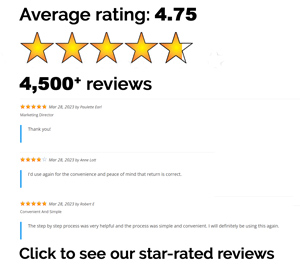The information in this article is up to date for tax year 2023 (returns filed in 2024).
Most taxpayers get a refund when they file their annual tax return, but that’s not true for everyone. Some taxpayers have a balance due to the IRS at tax time because they don’t have enough withheld from their paychecks, earned more than usual, or their tax situation changed and they no longer qualify for the same tax breaks they did in the past. The good news is with some proper planning you can avoid owing money next year.
Adjust your withholding
One of the easiest ways to avoid a tax time surprise is to check your tax withholding annually. It is also necessary to review your W-4 withholding anytime your personal or financial situation changes. If you owe the IRS money at tax season, it may be time to update your W-4 form. To do this, download a W-4 Form from the IRS website, fill in your information and submit the form to your employer. We provide ez step-by-step instructions on how to fill out your W-4 form in our article here. To see whether you’re on track to get a tax bill or a tax refund, you can use the IRS withholding calculator. It can show you what adjustments must be made so you have the appropriate amount of taxes deducted from your paycheck. If too much federal income taxes are withheld, you are owed a refund. If you have too little withheld, you may end up owing taxes.
Pay estimated taxes if you are self-employed
Do you work in ride-sharing or food delivery? Have your own business? You may have to make quarterly estimated tax payments. Typically, this applies to individuals who are self-employed, freelancers, and contractors because taxes aren’t automatically withheld from their pay. If you expect to owe more than $1,000 in taxes when you file your annual return, you’ll need to pay estimated taxes. In 2024, estimated tax payments due April 15th, June 17th, September 16th and next year January 15th.
Saving for retirement can reduce your taxable income
Saving for retirement can help you save money on your taxes and set you up to live comfortably in your golden years. You can open a traditional IRA, which will allow you to set aside up to $7,000 ($8,000 if you’re aged 50 or older) for 2024. However, if you’re looking to save more money, contributing to your employer’s 401k plan may be a better option. This year, you can contribute up to $23,000 to a 401k ($30,500 if you’re aged 50 or older). Aim to save as much as you can because every dollar you contribute lowers your taxable income, so you pay less income tax.
Be aware that unemployment benefits are taxable
Especially in today’s economy, it’s not uncommon for people to collect unemployment benefits to help stay afloat in-between jobs. However, many people don’t realize that it’s considered taxable income. If you don’t have any taxes withheld (or too little), you may wind up with a tax bill or smaller refund than anticipated. To avoid any surprises, it’s a good idea to complete Form W-4V, Voluntary Withholding Request so the government withholds taxes from each check.
Hold on to valuable receipts
When you do your taxes, you have the option of itemizing or taking the standard deduction. For tax year 2023, the standard deduction is $13,850 for single or married filing separately, $20,800 for head of household and $27,700 for married couples filing jointly. If your allowable expenses exceed that amount, then it makes more sense to itemize. The IRS allows you to deduct non-reimbursable medical and dental expenses, mortgage interest, charitable contributions, gambling losses, etc. So, holding on to the right receipts can save you money.
Take advantage of every legal tax break
The more tax credits and deductions you’re able to claim, the bigger your savings will be. Using ezTaxReturn to do your taxes minimizes mistakes and can help you take advantage of every tax break that’s rightfully yours. For instance, low-income workers can qualify for the Earned Income Tax Credit worth between $600 to $7,430 in tax year 2023. Families with children under 17 years old can claim the Child Tax Credit worth a maximum of $2,000 per qualifying child. College students can also qualify for education tax credits which can lower their tax bill or put money in their pocket. If you’d like to learn about some valuable tax breaks, you can read our article on the most commonly missed tax breaks here.
File your taxes fast and ez with our step-by-step guidance.
The articles and content published on this blog are provided for informational purposes only. The information presented is not intended to be, and should not be taken as, legal, financial, or professional advice. Readers are advised to seek appropriate professional guidance and conduct their own due diligence before making any decisions based on the information provided.




